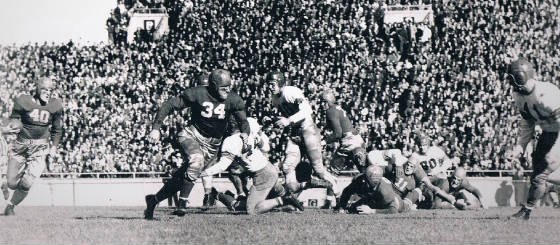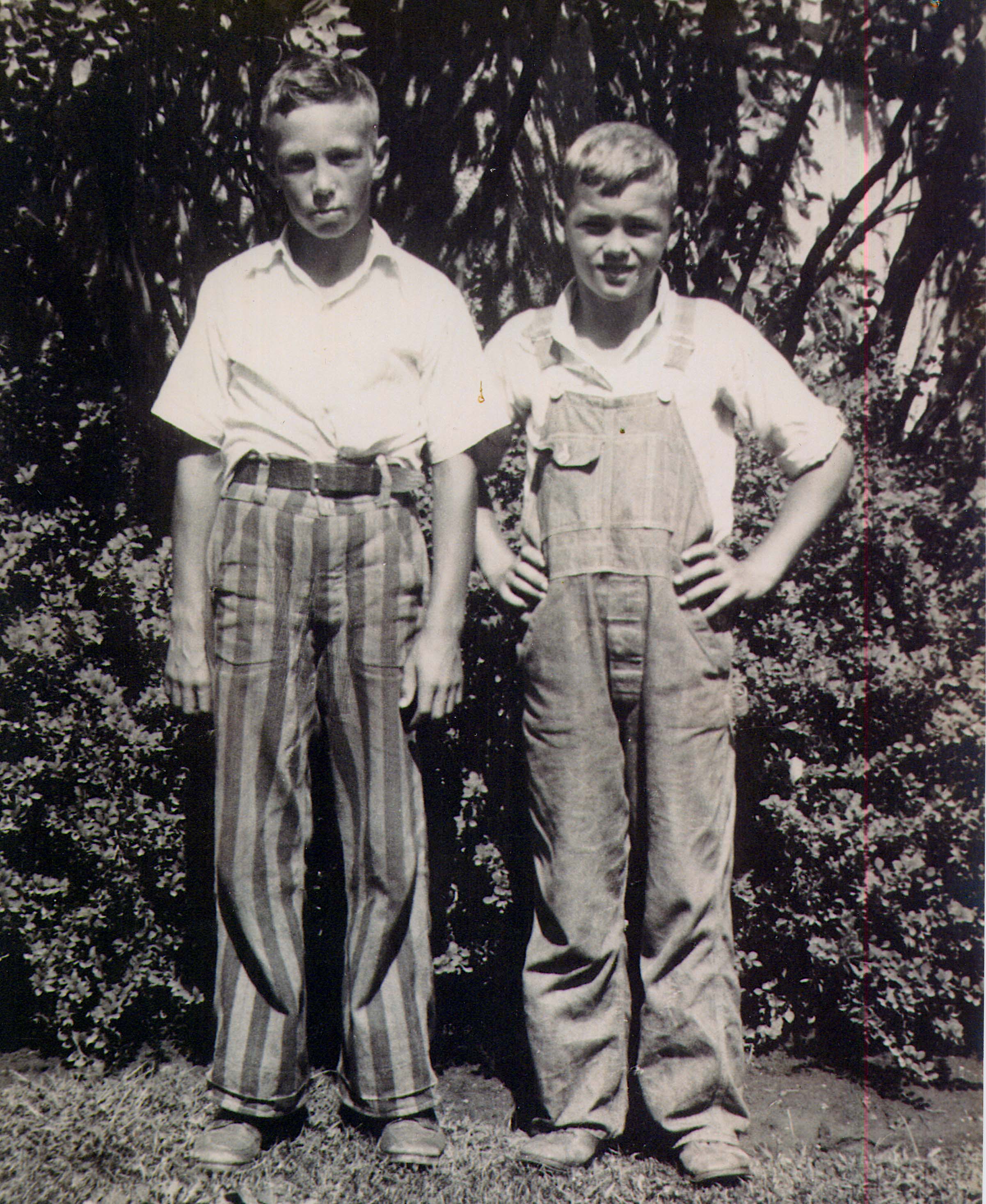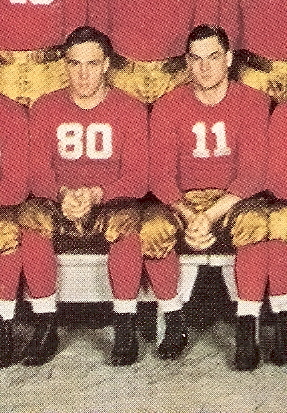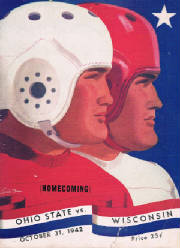| |
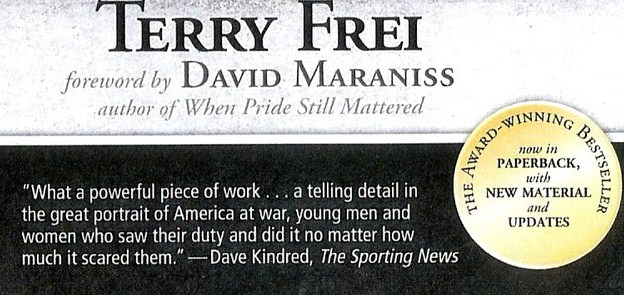
Terry Frei has
written the screenplay adaptation. For screen rights and screenplay inquiries, click here. "Terry Frei set out to learn more about his father. He wound up bringing to life a team, a cause
and an era. Likewise, all that the young men of the 1942 Wisconsin Badgers set out to be was college students and football
players. But circumstances called most of them to do something greater: Save the world. Impressively researched and reported
and powerfully written, Third Down and a War To Go will put you in
the huddle, in the front lines and in a state of profound gratitude -- not only to the Badgers and the hundreds of thousands
of men like them, but to Terry Frei.” --Neal Rubin, Detroit News and
author of Gil Thorp From the book
jacket/cover: 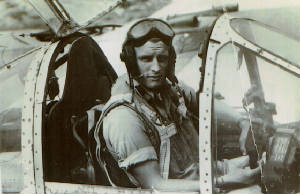 When longtime University of Oregon coach Jerry Frei died in 2001, many of his former Ducks players
attending his memorial services were astounded to learn that he had been a decorated P-38 fighter reconnaissance pilot in
World War II. He hadn't brought that up with his players, nor with those he worked with in his subsequent 30-year stint as
an NFL assistant coach, scout and administrator. Like so many other veterans, he hadn’t talked much about the war with
his children, either. 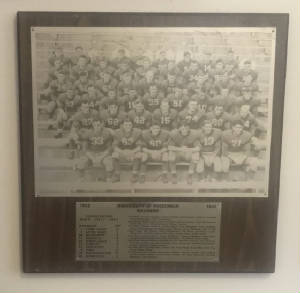 Late in Jerry Frei’s life, his son, Terry, belatedly began asking more questions about the young pilot’s
experiences. As the father and son talked, a frame of reference was the Wisconsin Badgers’ 1942 team picture plaque
on Jerry Frei’s den wall. Sophomore backup guard Jerry Frei, then only 18, was in the fourth row, behind All-American end Dave Schreiner, bedrock
tackle Bob Baumann, and star halfback Elroy “Crazylegs” Hirsch; and just in front of renowned fullback Pat "Hit
'em Again" Harder. The elder Frei spoke of how
the players on one of the greatest college football teams of all time went off to serve their country after their glorious
season – and about how not all of them made it back. After his father’s death, Terry Frei set out to learn more about the team and the men in that picture. What he
learned left him forever changed. On December 11, 1941, Schreiner wrote to his parents, “I’m not going to sit here
snug as a bug, playing football, when others are giving their lives for their country. . . . If everyone tried to stay out
of it, what a fine country we’d have!” Schreiner didn’t stay out of it. Neither did his teammates. 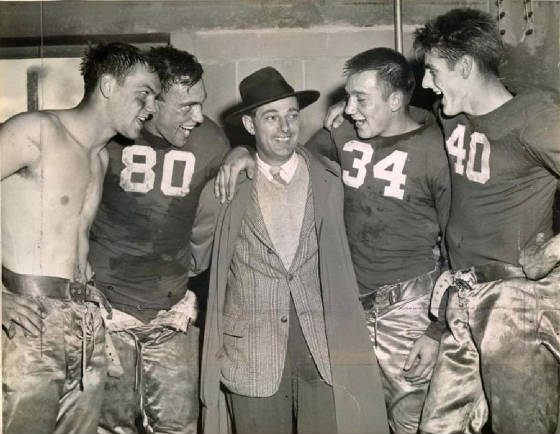
Mark Hoskins, Dave Schreiner,
coach Harry Stuhldreher, Pat Harder and Elroy "Crazylegs" Hirsch after the Badgers' 17-7 victory over Ohio State
that should have decided the national championship. It didn't. In the final-fling atmosphere common on college campuses as the first year of U.S. involvement in the war
was winding down, Wisconsin climbed up the national rankings under the guidance of coach Harry Stuhldreher, the quarterback
of Notre Dame’s famed “Four Horsemen.” Most Badgers had enlisted in various branches, were awaiting their
callups, and knew that each game brought them closer to military service. Schreiner and the Badgers’ other co-captain,
halfback Mark Hoskins, both came from tiny Lancaster, Wisconsin, and the long-time buddies and teammates both planned to become
pilots. But Schreiner’s color blindness ruled him out as a pilot, and after he renounced a pre-medicine student deferment,
the two-time All-American end became a Marine officer in the same company as teammate Bob Baumann. Hoskins became a B-17 bomber
co-pilot. As the war raged on, the Badgers sailed through Harm’s Way, fought in the Battle of the Bulge, pushed the envelope
as pilots, led units in the fierce island battles...and more. Through
exhaustive research and interviews in 2002-03 with the remaining Badgers, their families, and combat comrades, Terry Frei
told the story of this band of brothers. It is not a tale focusing only on a few stars. It is a saga of teammates answering
the call and heroism throughout the roster. Stars and scrubs did what they were asked to do -- what had to be done -- in various
services in both Europe and the Pacific. In particular, the climactic material about the "Great Escape" prison camp,
plus the Battle of Okinawa and the role of several Badgers in it, has tugged at readers’ hearts. Readers
and reviewers agree: It's an All-American story. "Terry Frei has captured the spirit of a different
time in this country, a time of faith in school and in country, a time of intense loyalty to teammate and fellow soldier. Third Down and a War to Go tells the story of one University
of Wisconsin football team during World War II. But to limit the tale to that is like saying Angela's Ashes is about Ireland. This book brings to life, in
shades of black and blue and blood red, the idea that certain things are worth fighting for." -- Rick
Morrissey, Chicago Tribune Crazylegs
Hirsch (40) about to break a 59-yard run against Ohio State, behind an imminent block from Pat Harder (34).
"Mythology
is nice. Truth is better. The '42 Badgers were boys being boys. Good for them. Good for Terry Frei, who chose to write their
story truly in his book, Third Down and a War to Go: The All-American 1942 Wisconsin Badgers.What a powerful piece of work the book is, a telling detail in the great
portrait of America at war, young men and women who saw their duty and did it no matter how much it scared them." -- Dave Kindred, The Sporting News and
author of Sound and Fury
The Lancaster Boys: Dave Schreiner and Mark Hoskins
were the '42 Badgers' co-captains.
"...a
book that not only makes you keep reading, but makes you care...The last chapter in Frei's book, 'Lives and Deaths,' details
what happened to everyone from that squad, and by the time you get there, you really want to know about them. It's that kind
of book, relatively modest in intent but rich in fabric and execution." --Dwight Chapin, San Francisco Chronicle 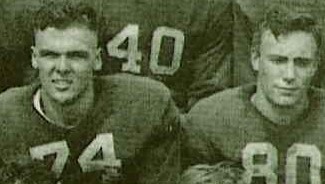 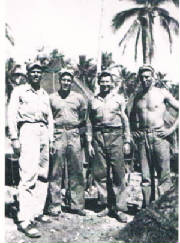
Top: Bob Baumann (74) and Dave Schreiner (80) in the
team picture, taken on the first day of pre-season practices. Then Baumann is at left, Schreiner at right, as Marine lieutenants in the same company heading into the Battle of
Okinawa. “Tirelessly researched and relentlessly touching. The true allegory of football and war, minus the
cliches.” --Jay Greenberg, New York Post 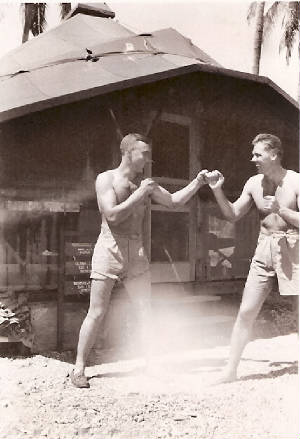 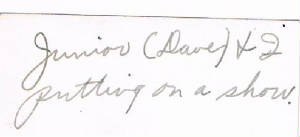
From the
Pacific, Bob Baumann sent this picture to fiancee Arlene Bahr, with his handwritten "caption" on the
back. Dave Schreiner
is at left, Baumann at right. “Many times you hear athletes
called heroes, their deeds and accomplishments on the field or court are characterized as courageous. After reading Third
Down and a War to Go, I am embarrassed to have ever been thought of as brave or courageous. Enjoy this adventure in history,
life, and in courage and take it from a so-called ‘tough guy’...keep the hanky close by.” --Dan Fouts, Hall of Fame quarterback and sportscaster 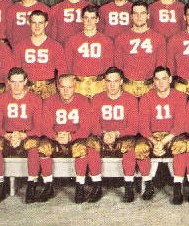 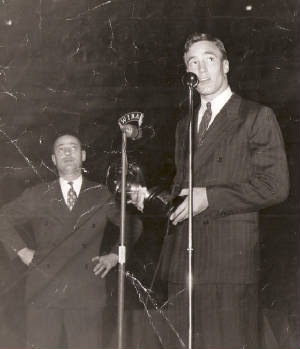
Left: Pulling back a bit in the later team color photo,
clumped together are Jerry Frei (65), Crazylegs Hirsch (40), Bob Baumann (74), Dave Schreiner (80) and Mark Hoskins (11). Right:
With Harry Stuhldreher watching, Schreiner accepts the Chicago Tribune Silver Football as Big Ten's 1942 MVP. "David
Nathan Schreiner was far more distinguished off the field, a reality brought to life in the must-read book Third Down and a War to Go, by Terry Frei" -- Andy Baggot, Wisconsin State Journal Book excerpt: Dave Schreiner 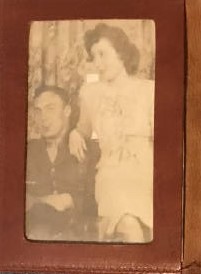 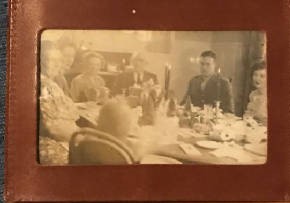 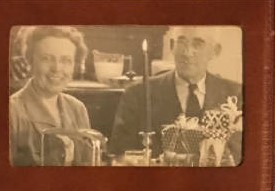 Photos are of the Phi Delta Theta picture wallet Dave Schreiner was carrying on
Okinawa. This was from Thanksgiving 1943 at the Schreiner home in Lancaster. Schreiner is with Odette Hendrickson, his fiancee;
and with his family. His parents, Anne and Bert, are at right. The Schreiner family gave the wallet to Terry Frei. "Here’s a book written with love and passion
. . . What began as a sports book comes to resemble something akin to 'Band of Brothers,' by the late Stephen Ambrose (who
played for the Badgers more than a decade later). . . This is an inspiring book, full of fun and pathos and heroism." --Dave Wood, past vice-president of the National Book Critics Circle and former book review
editor of the Minneapolis Star Tribune. 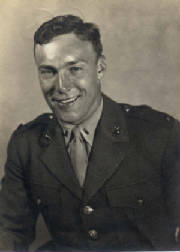 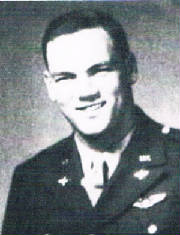
Lancaster
Boys and Badger co-captains: Marine Lt. Dave Schreiner and B-17 co-pilot Mark Hoskins. Hoskins was shot down on June 27, 1944. "The drama, heroism and pathos of this
book would make a great movie that would star two Grant County men -- Lancaster's Dave Schreiner and Mark Hoskins." --Jon
Angeli, Grant County Herald-Independent 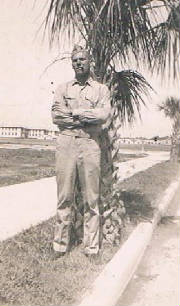 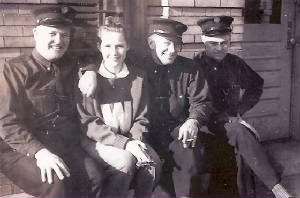
Bob Baumann sent this picture from the Pacific to Arlene
Bahr. In return, she sent him a copy of the picture at right, showing her visiting the firehouse where Bob lived and received
a free room. When they were at the firehouse, they were tasked with or shutting the big doors after the engines departed
and opening them again when appropriate. Other Badgers had the same deal at other Madison firehouses -- including Jerry Frei. Adapted book excerpt: Bob Baumann "With its members serving on all fronts, the 1942 Wisconsin Badgers
become a microcosm of the American war effort, representatives of a remarkable generation of self-sacrificing Americans. .
. . Through Hoskins and Schreiner, the cocaptains of the 1942 team, the author makes his most important point. Frei portrays
the young men who played football at the University of Wisconsin in 1942 and later fought for their country as truly 'All-American'
boys. Having embraced the opportunity to serve his country and risk the ultimate sacrifice, Dave Schreiner -- as both a star
athlete and all-American on the football field as well as a man of impeccable character off it -- was the definitive symbol
of this. Written with the passion of an inspired student, Third Down and a War to Go is fulfilling and powerful. It adds athletic perspective to our understanding of the 'Greatest
Generation' as well as a window into their rural, midwestern lives and their roots as athletes, students, and friends." -- Shane Butterfield, Michigan Historical Review  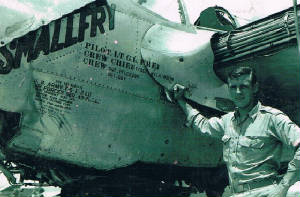
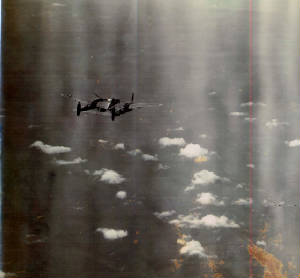
That's Jerry
Frei in his P-38 on the last of his 67 missions. The F-5 version of the P-38 Lightning was unarmed, with cameras replacing
the guns. The job was to fly in alone over enemy targets, or with one other plane, to take pictures in advance of the bombing
runs. His unit, 20 pilots at full strength, lost eight men during his tour.
Grateful for the Guard: The story that started it all “Terry Frei has done a superb job of researching and writing to bring us the true spirit and similarity
of our military services, particularly the U.S. Marines, and college football. He vividly follows the nation’s number
three ranked 1942 Wisconsin Badgers who so soon after their gridiron exploits lost life and limb fighting in the Pacific.
Events of over sixty years ago seem to have been frozen in time by Frei—taking us back to the glory days of so many
young Americans.” —Bob
Rennebohm, Wisconsin end (1942, 1946–47), Marine lieutenant (1943–45), and longtime head of the University of
Wisconsin Foundation
Book excerpt: Massillon (Paul Brown's Buckeyes vs. Harry
Stuhldreher's Badgers.) "Of
all the traits of the World War II generation, perhaps the most impressive some 60 years later is the ability to make do,
no matter the circumstances, and with little ceremony at that. That theme echoes throughout author Terry Frei's thoroughly
researched and ardently objective book, a chronicle of the 1942 Badgers' rapid transition from carefree college clashes against
Notre Dame and Minnesota to battling Nazi Germany and imperial Japan. . . The first half of the book establishes the principal
characters and the 'swell' atmosphere of the day, to borrow some period terminology, while detailing an 8-1-1 season in which
the Badgers were deemed mythical national champions by the Helms Foundation. With the war heightening, the majority of the
players were sent overseas to fight on the front lines, and Frei follows them relentlessly in the book's second half, focusing
mainly on (Dave) Schreiner and (Mark) Hoskins. It's a logical choice, given their long friendship, their disparate assignments
and Schreiner's status as an All-American . . . Either half of the book would have stood alone, but together they do
supreme justice to a group all too soon gone, all too easily forgotten." --Adam Mertz, The Capital Times,
Madison 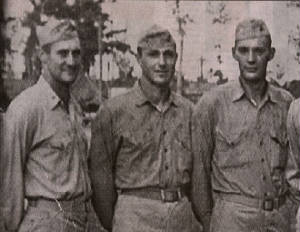 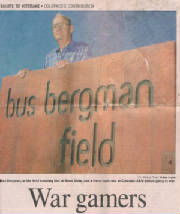
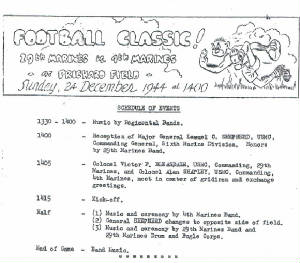 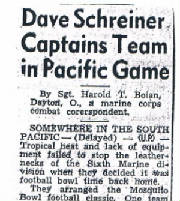
Badgers Dave Schreiner,
Bob Baumann and Bud Seelinger were among the Marines, many of them former college stars and even pros, who played in the 4th
Regiment vs. 29th Regiment "touch" Football Classic on Guadalcanal on Christmas Eve, 1944. At left, tentmates and
Football Classic players George Murphy of Notre Dame, Dave Mears of Boston University, and Walter "Bus" Bergman
of Denver North High and Colorado A&M (State). Terry Frei utilized his research on the game -- which also came to be called
the "Mosquito Bowl" -- and the men in it for several pieces, including for The Denver Post (Nov. 2, 2003) and
ESPN.com in 2004, plus in Third Down and a War to Go.
Here's Frei's omnibus web site version and background of how it came
about: Mosquito Bowl Book excerpt: The POW experiences of Badgers Mark Hoskins and Don Pfotenhauer "While Schreiner's is among the most compelling,
the stories of these young men and their efforts and the battlefield recall a different era. . . These Badgers did their job
as teammates on the gridiron, and they headed off together to fight the Germans and Japanese, united in their purpose and
with a grateful nation behind them." -- Scott Angus, editor, Janesville
Gazette, son of team manager Robert Angus Terry Frei's writing on additional Badgers and World War II heroes "I’ve already mapped out
one of the first trips I intend to make when I get back to Wisconsin. I’m going to drive the highways
winding through the beautiful rolling hills southwest of Madison to pay my respects to Had Hoskins and Dave Schreiner,
the Touchdown Twins, who are buried at Lancaster’s Hillside Cemetery, side by side."
-- From
the foreword by David Maraniss
"Great
job. So good that I was brought to tears. So good that I almost need to visit the cemetery in Lancaster, Wis., and say 'thanks'
to Dave Schreiner and Mark Hoskins." --Randy
Jesick, journalism professor, Indiana University of Pennsylvania “This is a story of the highest degree, one that
will leave the reader at various times laughing, mournful, amazed, and inspired. Third Down and a War to Go is much more than
just a football story. It is much more than just a war story. It is a story about us.” —Doug Warren, Badgernation.com |
|






